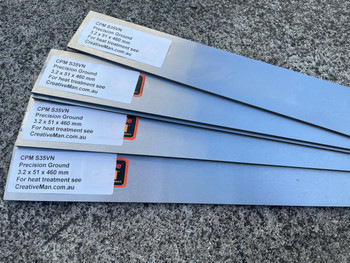How To: Heat treating 80CrV2 Steel
- Gift wrapping:
- Options available
Description
How to Heat Treat 80CrV2 Carbon Steel:
80CrV2 is a popular blade steel in Finland, most all of the Lauri, Polar and Laurin and many of the Brisa carbon blades are made in just this steel. It is a steel similar to 1084 with the added Vanadium and a touch of Chromium helping with refined grain size but unlike 1084 this is not a "real" oil-hardenable steel.
In small sections like for knife blades a fast oil quench is enough but for larger cross-sections this is a water-quenching steel. We think of 80CrV2 as "1084's angry cousin" where the longer soak time justifies the somewhat better edge retention and toughness.
Get 80CrV2 here: LINK
Heat treating 80CrV2:
- normalise at 843-900 C (1550-1650 F) for 10-15 mins and air cool to black x 3 times
- heat to 830 C (1525 F)
- hold for 10 mins for "knife blade thickness" (20 mins if 7+ mm)
- Quench in a fast quench oil is best, medium speed oil acceptable for 1/4" or less thickness
- Temper immediately at 175-204 C (300-450 F) for 2 hours x 2 times*
Tempering:
Cool in water after first tempering and then temper for another 2 hours. Temperature is depending on toughness needed. (If in doubt, 200 C (450 F) is the way to go for about 60 HRC.)
Annealing:
If annealing after forging before heat treatment: Hold at 760 C (1400 F) for 30 mins, then slowly cool.
There is evidence steel that is annealed heat treats differently to steel that is not annealed. Read more on Knifesteelnerds.com if wanting to know more. This is not common among most knife makers still as of 2024 but there is interesting work being done in this space suggesting that annealing before heat treatment can give several HRC points higher hardness: LINK
Optional cryo:
Dr Larrin Thomas' tests are showing that all blade steel will benefit from cold treatment between the quench and tempering so kitchen freezer or dry ice treatment will add some additional hardness if you take the time.
Forging:
Do not forge over 1050 C (2100 F) due to excessive grain growth.
Big Thank-you for the heat treatment summary from Dr. Larrin Thomas in "Knife Steel Engineering"
We are here paraphrasing to simplify, any errors are ours and not Dr Thomas' fault.










